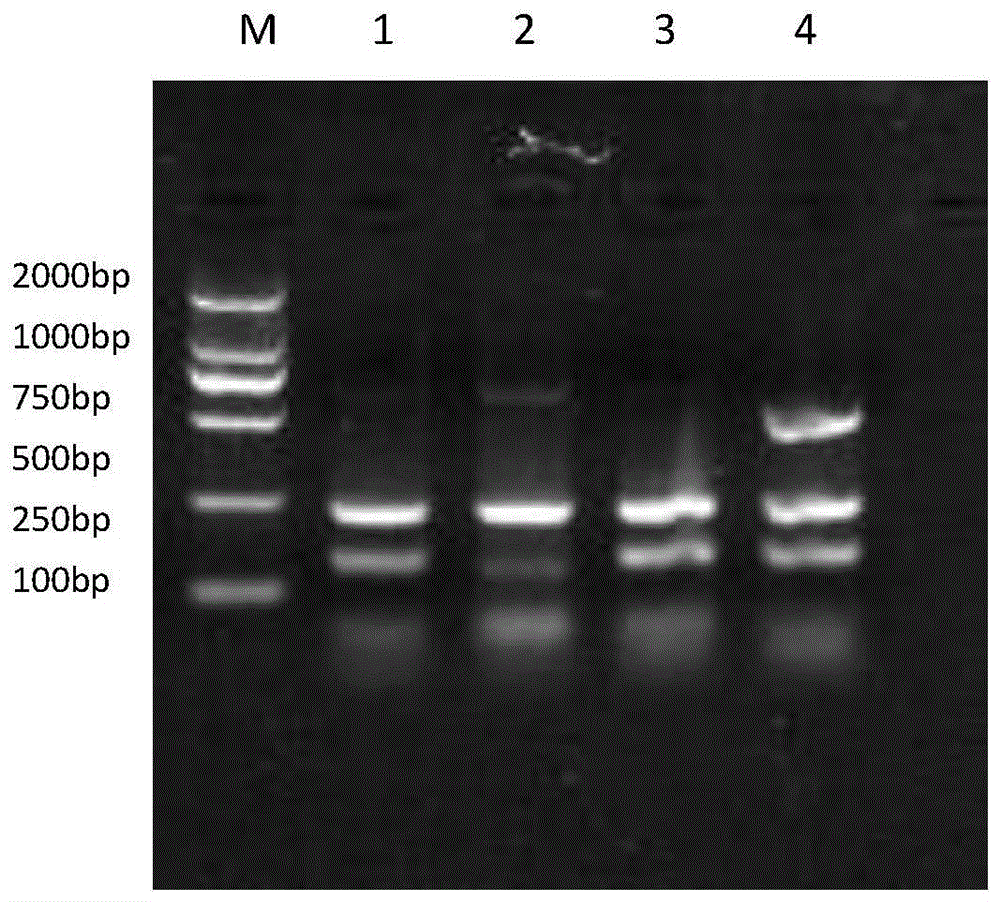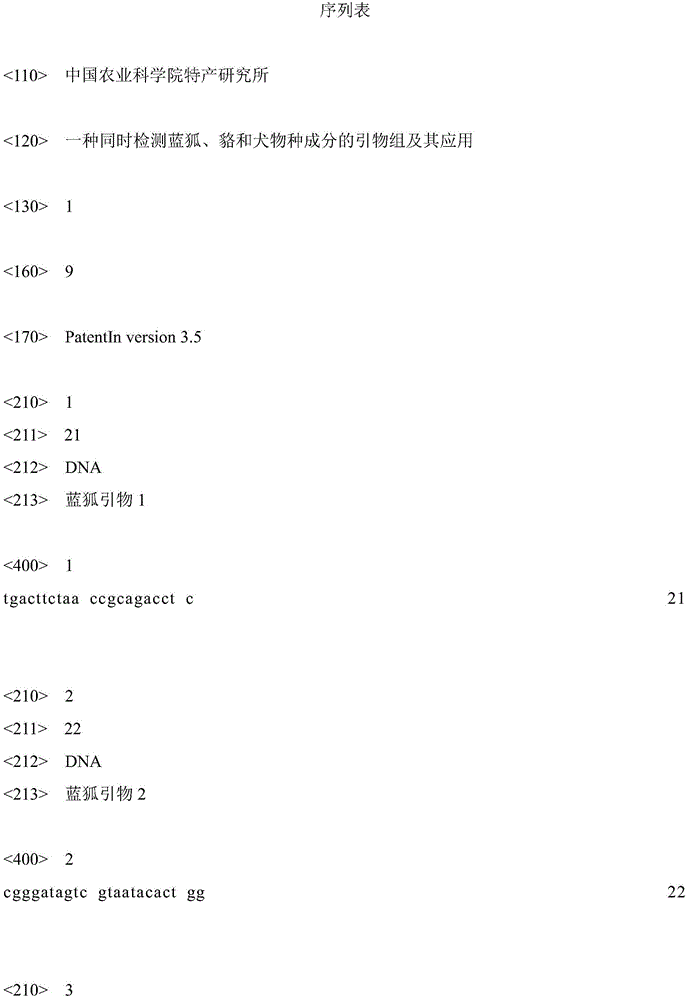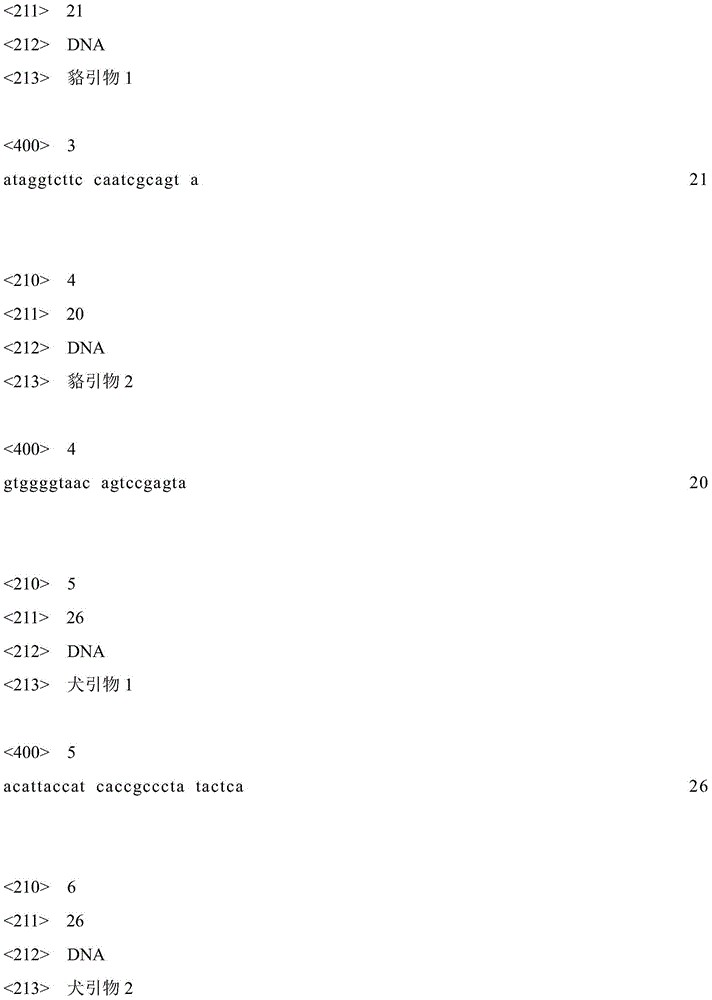A Primer Set for Simultaneously Detecting Species Components of Blue Fox, Raccoon and Dog and Its Application
A primer set and species technology, applied in recombinant DNA technology, microbial determination/inspection, biochemical equipment and methods, etc., can solve the problems of less identification and detection, lack of effective detection and differentiation of canine components, etc., and achieve low cost. , good potential economic and social benefits, high specificity effect
- Summary
- Abstract
- Description
- Claims
- Application Information
AI Technical Summary
Problems solved by technology
Method used
Image
Examples
Embodiment 1
[0024] Example 1 Extraction and Primer Design of Animal Blue Fox, Raccoon and Dog Mitochondrial Genomic DNA
[0025] Take 200 mg of muscle tissue from three kinds of animals respectively, and use the mitochondrial genomic DNA extraction kit, purchased from Beijing Baihao Biotechnology Co., Ltd. The extracted DNA was dissolved in TE buffer and stored at -20°C for later use.
[0026] 1. Sample Processing
[0027] a. Tissue homogenate: Weigh 100-200 mg of fresh tissue such as liver, brain, myocardium, etc., rinse with PBS or normal saline, wash the blood, blot dry with filter paper, cut into pieces with scissors and put them into a small-capacity glass homogenizer . Add 1.0 mL of ice-cold cell lysate, and grind the tissue up and down in an ice bath at 0°C for 20 times;
[0028] 2. Transfer the tissue or cell homogenate to a centrifuge tube, centrifuge at 1000×g for 5 minutes at 4°C;
[0029] 3. Take the supernatant, add it to a new centrifuge tube, and centrifuge again at 100...
Embodiment 2
[0041] Embodiment 2: PCR amplification and amplification product identification
[0042] The extracted blue fox, raccoon dog and canine mitochondrial genomic DNA were amplified by PCR;
[0043] The reaction system for PCR detection is 50 μL: 3 μL of extracted sample DNA template; 1.0 μL of each of the upstream primer and downstream primer; 25 μL of rtaq mix 2x enzyme, and 25 μL of pure water.
[0044] The PCR reaction program was as follows: pre-denaturation: 94°C, 3min; entry cycle: denaturation at 94°C for 60s, annealing at 58°C for 60s, extension at 72°C for 60s, 35 cycles; termination extension: 72°C, 7min; storage of the reaction product at 4°C.
[0045] PCR product electrophoresis detection and product sequence analysis: PCR products were electrophoresed in 1.0% agarose gel, and after 15 minutes, the gel imaging system was observed, and the three species of Canidae could be initially distinguished and identified by the size of the species-specific bands animal.
[0046...
Embodiment 3
[0047] Example 3 Simultaneous detection of blue fox, raccoon dog and dog species components in meat products
[0048] The market buys mutton, beef, pork, chicken, and dog meat; the experimental station collects muscle samples from fur animals such as blue foxes and raccoon dogs. The mitochondrial genome of each sample was extracted and detected by electrophoresis. And use a spectrometer and a nucleic acid analyzer to detect the concentration and purity. Samples that meet the requirements are frozen and stored for subsequent experiments.
[0049] 1. Single PCR detection
[0050] The obtained template DNA was individually added to any pair of primers in the three animals, and the result was that no specific band could be amplified for any primer pair in the mutton, beef, pork, and chicken templates. The primers of blue fox, raccoon dog and dog all showed specific bands for their own species, but the primers of blue fox and raccoon dog failed to obtain specific bands in dogs. ...
PUM
 Login to View More
Login to View More Abstract
Description
Claims
Application Information
 Login to View More
Login to View More - R&D
- Intellectual Property
- Life Sciences
- Materials
- Tech Scout
- Unparalleled Data Quality
- Higher Quality Content
- 60% Fewer Hallucinations
Browse by: Latest US Patents, China's latest patents, Technical Efficacy Thesaurus, Application Domain, Technology Topic, Popular Technical Reports.
© 2025 PatSnap. All rights reserved.Legal|Privacy policy|Modern Slavery Act Transparency Statement|Sitemap|About US| Contact US: help@patsnap.com



